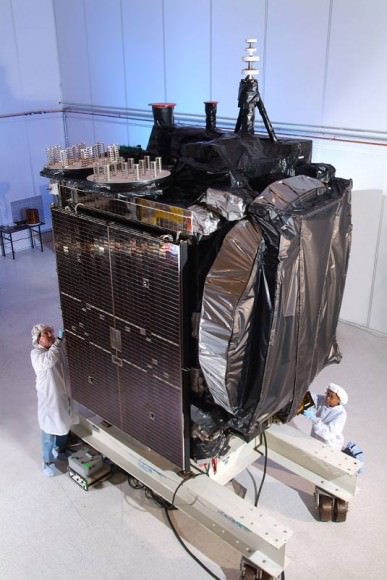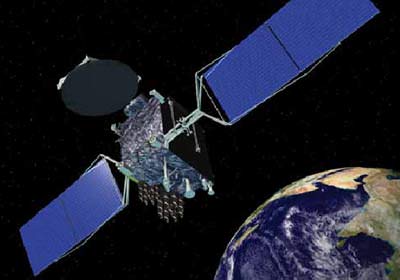[/caption]
A geostationary satellite that had its “brains fried” by a solar flare (love that description by our pal Ian O’Neill at Discovery Space) stopped communicating with ground controllers last month and remains out of control. While the Galaxy 15 communication satellite is still functional, its navigation and communications system are not. The instruments remain “on” but the satellite has drifted out of its assigned orbital slot and will soon be coming close to other satellites. While it likely won’t crash into other satellites, the rogue satellite can cause problems when it enters an orbital space occupied by other satellites by “stealing” their signal, thereby interrupting other vendor’s services to customers on Earth.
Space News reports that a satellite operating at full payload power that is no longer under control is unprecedented, and the company that operates the satellite, Intelsat, is seeking advice from other satellite operators and manufacturers.

On May 3, Intelsat tried unsuccessfully to shut down the electronics payload so that it wouldn’t interfere with any other satellites. Earlier, Intelsat tried a fruitless effort of sending between 150,000 and 200,000 commands to the satellite to coax it back into service, and then on Monday tried to force the satellite to shut down its transponders, and ultimately the satellite’s payload.
Galaxy 15, which normally operates at 133 degrees west longitude 36,000 kilometers over the equator, is now closing in on the geostationary orbital slot just two degrees away occupied by another satellite using the same bandwidth (C-band) the AMC-11 spacecraft operated by SES World Skies. With its active payload, Galaxy 15 could cause potentially severe interference with the SES satellite during a two-week period starting around May 23, according to Space News.
Galaxy 15 relays Global Positioning System (GPS) navigation information to in-flight aircraft.
The various satellite companies are working together to figure out how to deal with the problem. Check out Space News for more information.


Now would be a good time for a space tug.
I am thinking about an ion driven space tug that could grab the satellite, slow it down, release it and speed up again to stay in orbit while the satellite comes down.
Could not our military have a little practice?
OR
Space shuttle anyone?
@elric – no, the satellite can’t be used for target practice. Offcourse is possible, but the space debris could cause more problem in the future.
The problem is the satellite’s software design. It should disable itself in case it can’t be receive any signals from earth in 10 days, for example.
“…May a stranger, and not your own mouth, praise you; may a foreigner, and not your own lips, do so. …” Proverbs 27:2
In geostationary orbit?!! Why not take a stroll across Africa while we’re at it?
If communications still work, isn’t it more like a paraplegic than a zombie?
BRAINS…. BRAINS….
A space tug a day is just what the space doctor would have ordered for this complication.
@ tristancalin:
Good idea, but likely the electronics were fried and presumably the software with it or before it. Perhaps there is no ROM software to reload, or it was fried as well.
A hardware timer dead man’s hand shutdown would be hardier and could have been made redundant (also possible for software ones, of course), but there would never be a guarantee.
Plus, businessmen are risk adverse, and a dead man hand system is a slight risk to the business and the purse.
This would be a good time to “tug” the zombie using techniques you’d use for killer asteroids.
A space tug is fine but a space HUG would be even better. Satellite needs love.
I wonder if the X-37B has the cap. to reach geosynchronous orbit? Then maybe ZAP the rogue with an EMP cannon? But that would be telling… now wouldn’t it?
EVA-1 of STS-125, May 2009, added grapple fixtures to the HST so that a later robotic mission (X-37B based?) could then attach a de-orbit module. This is a tidy solution to the growing issue of dysfunctional spacecraft as no space junk remains in orbit to threaten other instruments thereby meeting the Space Commands “Risk Reduction” mission.
A X-37B equipped with present day ion thrusters of the type used on Smart 1 or Dawn (capable of accelerating at 15 mph/day ~ 24 km/h/day), could reach geostationary orbit from LEO in around 50 days. You have to allow more time for the X-37B to decelerate to a halt on reaching the target, but even so, the return trip seems well within the X-37B’s endurance of 270 days including the time required for operations such as attaching a de-orbit module to a target satellite(s).
Sssssh….